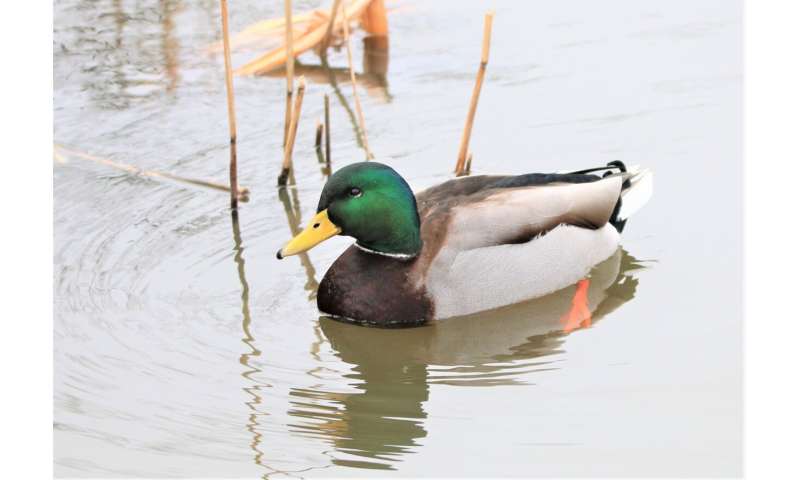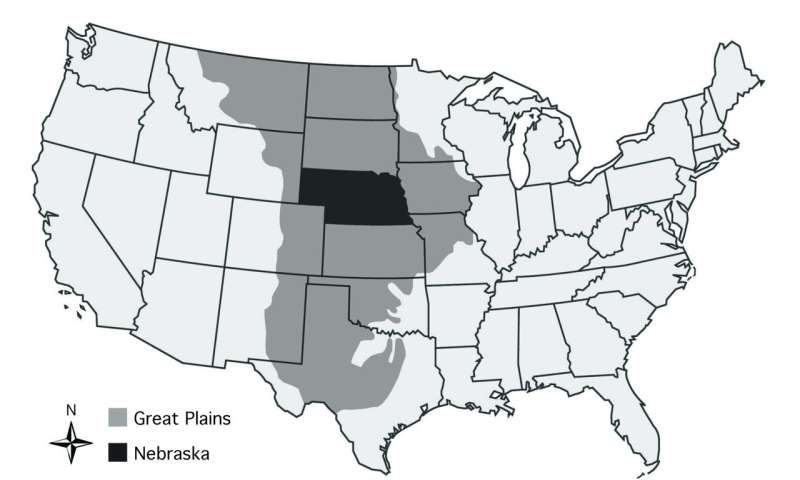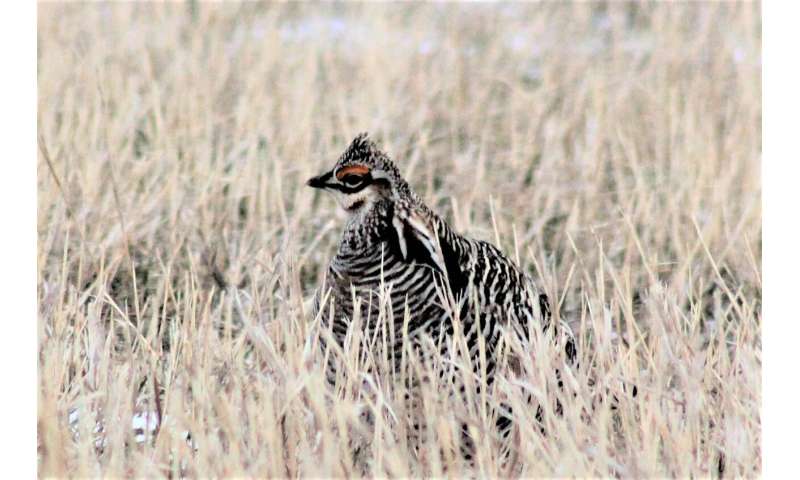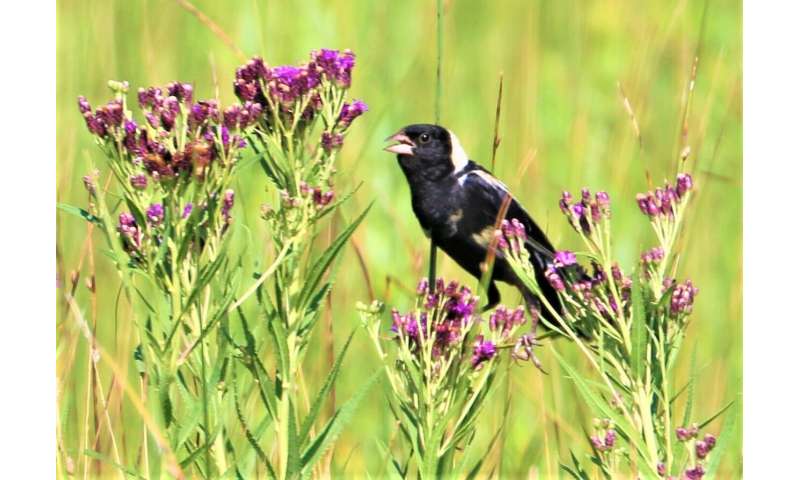Making hay while the birds nest? Study finds landowners willing to protect grassland birds nesting in their hay fields

Grassland bird populations have been steeply declining for decades, and conservationists are in a race against the clock to find ways to prevent their continued losses. Temperate grasslands are some of the least protected and most endangered habitats on Earth due to their conversion to human use, especially for agriculture, which is considered a primary driver of grassland bird declines. Research in North America also links agricultural pesticides to these declines.
Many studies in both North America and Europe show that protecting grasslands from mowing for hay during the main bird breeding season makes a critical difference for grassland birds. Despite how well-hidden grassland birds' nests may be from predators, they cannot survive mechanical hay harvest operations. Numerous studies have shown that although adult birds may escape and survive, eggs and chicks do not, and brooding females may also be killed in hay harvest operations.
Timing is everything
A decision on whether to delay hay harvest operations until after the end of the main bird breeding season, which is often recognized as July 15, can mean life or death for many grassland birds and their nests. Most grasslands are privately owned, so the decision on when to harvest hay is made by the landowner. From the landowner's perspective, delaying haying can be problematic because both the nutritional and economic value of hay peak in early to mid-summer. Because of this trade-off between economic and conservation concerns, understanding landowners' motivations and decisions is key in areas like the North American Great Plains, where 98% of land is privately owned.

Although delaying hay harvests for bird conservation is a goal highlighted in many studies, very few researchers have investigated landowners' willingness to do so. We conducted mail surveys with almost 300 landowners in two counties in the Nebraska Sandhills to assess their willingness to delay harvesting hay for bird conservation. We found only one previous study on this question in the United States, which examined the attitudes of dairy farmers in Vermont towards the possibility of delaying hay harvests for bird conservation.
Who will consider delaying hay harvest for birds?
We hypothesized that Nebraska Sandhills landowners with livestock would be more likely to delay haying for bird conservation than those without livestock, in part because the prior study from Vermont found this correlation. We also hypothesized that landowners with greater knowledge of wildlife would be more willing to delay haying, since they may also have more concern for wildlife conservation. Finally, we expected that hunting activity would have a positive correlation with landowners' willingness to delay haying for bird conservation. Studies in the U.K. and Europe have shown that hunters support conservation, and the North American model of wildlife conservation also links responsible hunting with wildlife conservation.

We expected hay producers to be more familiar with game bird species, which tend to be larger and more conspicuous than other bird species, and therefore that they might be more likely to delay hay harvest for their sake compared to songbirds. We tested this hypothesis by asking landowners about their knowledge of four locally nesting bird species that are relatively visible and recognizable: the mallard (Anas platyrhynchos), greater prairie-chicken (Tympanuchus cupido), western meadowlark (Sturnella neglecta), and bobolink (Dolichonyx oryzivorus).
A welcome surprise
Nearly two-thirds of respondents indicated that they were either "willing" or "very willing" to delay harvesting hay for bird conservation. Being knowledgeable about or liking birds is one thing, but being willing to make financial sacrifices for them is another. Nevertheless, 60% of Nebraska Sandhills landowners indicated their willingness to plan their haying practices around birds. A welcome surprise, this was a higher proportion of landowners than in two comparable studies—both the Vermont study and another study conducted in Kenya. This may in part reflect the land-ethic that Aldo Leopold famously described in his book, "A Sand Country Almanac," in which people regard themselves as stewards of the land because it is passed down for generations.

As we predicted, landowners with livestock operations were more likely to delay haying than those without livestock. Pinpointing the reasons for this correlation would require follow-up inquiries, but it may have to do with producers' confidence that their hay would still be of value to their livestock if harvested later. Also, as predicted, the more knowledgeable landowners were about birds, the more likely they were willing to delay haying for them. Moreover, although more respondents recognized mallards, greater prairie-chickens, and western meadowlarks than bobolinks, they were just as likely to delay haying for songbirds as for game birds.
Contrary to our expectation, we found that landowners who were also hunters were less likely than non-hunters to be willing to delay haying. This may be because most hunters in our survey were deer hunters, and the annual deer hunting season in this area takes place after the summer, which means there is a potential time conflict with delaying summer hay harvests. Hunters specializing in other game, such as pheasants or ducks, that have other hunting seasons, might show more willingness to delay haying for bird conservation, but further research is needed to identify whether or not this is the case.

Where there's a will, there's a way
Too often, conservationists focus on species declines rather than the solutions needed to address them. In this study, we were delighted to discover broad public support for grassland nesting bird conservation by private landowners in the Nebraska Sandhills. So where do we go from here? We hope that conservationists and landowners can work together to exchange information in support of delaying hay harvests for grassland nesting birds here and in other regions where landowners are willing to time hay harvests for grassland bird conservation.
Landowners who are willing to take action for conservation may do so independently or by participating in regional "bird-friendly" hay programs, including in the Midwest, Canada, and New England, and/or the U. S. federal Conservation Reserve Program, which provide information and financial incentives to offset income losses. We also encourage more studies that investigate landowners' attitudes towards bird conservation in order to better identify how wildlife knowledge influences conservation engagement and vice versa. Where there's a will for conservation, we can find a way to make it happen.
This story is part of Science X Dialog, where researchers can report findings from their published research articles. Visit this page for information about ScienceX Dialog and how to participate.
More information:
Matthew P. Gruntorad et al, Is Hay for the Birds? Investigating Landowner Willingness to Time Hay Harvests for Grassland Bird Conservation, Animals (2021). DOI: 10.3390/ani11041030
Bio: Nico Arcilla, Ph.D., is affiliate fellow at the University of Nebraska and director of the International Bird Conservation Partnership, whose mission is to foster and support research, outreach, and partnerships to advance the conservation of birds worldwide.